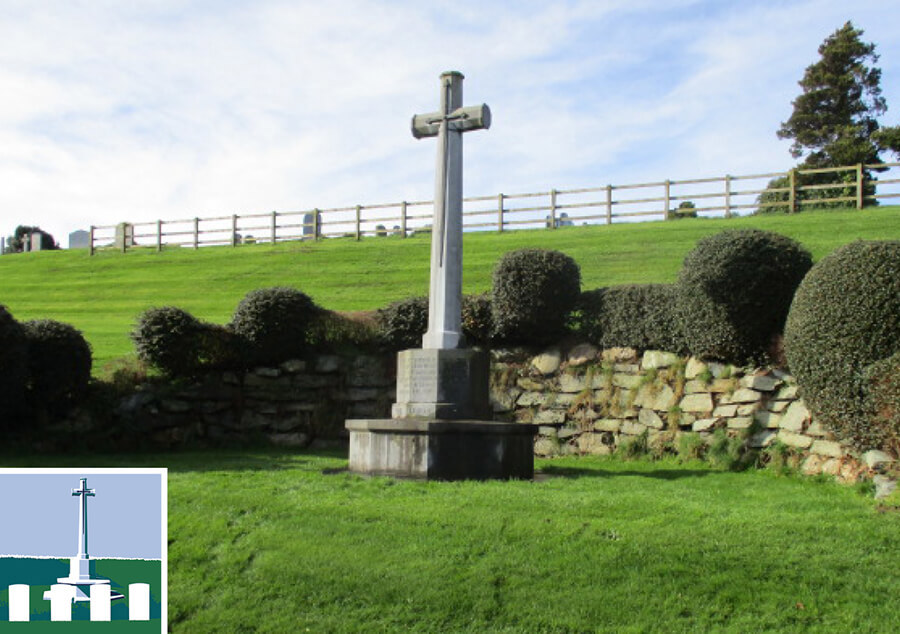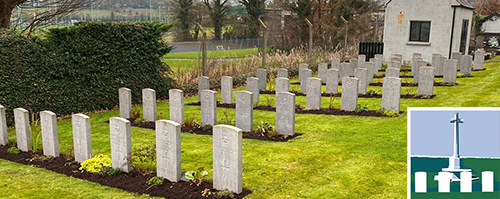Londonderry (Derry) City Cemetery
Londonderry City Cemetery was opened in 1853 and for the following hundred years was the main burial place for both Protestants and Catholics in the city. Amongst the 70,000 civilian burials are 194 Commonwealth war graves of the First and Second World War.

Londonderry City Cemetery was opened in 1853 and for the following hundred years was the main burial place for both Protestants and Catholics in the city. Amongst the 70,000 civilian burials, are 194 Commonwealth War Graves. There are 95 Commonwealth burials of the First World War here, and 99 of the Second World War, two of which are unidentified. In addition, there is one sailor of the Royal Netherlands Navy and 7 non world war servicemen buried in this war cemetery. Many of those servicemen buried here were recruited locally and belonged to the Royal Inniskilling fusiliers or served with the Royal Navy, which had an important naval base here during the Second World War.
Find out more
One of the first servicemen to be buried here was Lance Corporal Robert Dooley (grave MD. 558.). Robert was the son of Robert and Anne Dooley of 2 Well Street, Terrace, Londonderry and was a pre-war regular serving with Royal Inniskilling Fusiliers. Wounded at the First Battle of the Aisne in September 1914, Robert was evacuated to a hospital in Glasgow, where he died of his wounds on 23 September, aged 22. His body was brought home for burial in Londonderry City Cemetery. His headstone, which was erected by his family, also remembers his younger brother Lance Corporal Charles Dooley, also of the Royal Inniskilling, who was killed on 21 March 1918, aged 19, and is buried in Ste. Emilie Valley Cemetery, Villers-Faucon, France.

Men of the 11th Battalion, Royal Inniskilling Fusiliers in a captured German communications trench near Havrincourt during the Battle of Cambrai, November 1917. - © IWM Q 3187
In total there are 40 soldiers of the Royal Inniskilling Fusiliers buried in Londonderry City Cemetery. The Inniskillings were the country regiment for Donegal, Londonderry, Tyrone and Fermanagh with the garrison depot located at St Lucia Barracks in Omagh, Tyrone. The regiment had two regular battalions and raised nine New Army battalions during the First World War, which saw service on the Western Front, Gallipoli, Salonika, and Palestine. During the Second World War the Inniskillings fought in France in 1940 & 1944, Madagascar, North Africa, Italy, and Burma.
Following the partition of Ireland in 1921, the United Kingdom lost access to the ports on Ireland’s southern & eastern coast. With the outbreak of the Second World War and the start of the Battle of the Atlantic, the Admiralty decided to develop a large new naval base at Londonderry, now the UK's most westerly port, to serve as a base for convoy escorts, anti-submarine operations, and repair and refuelling facilities. Four important wartime airfields were also established close to the city, one of which, RNAS Eglinton (HMS Gannet), later became the City of Londonderry Airport.

Three sailors look out across numerous destroyers moored alongside each other after returning home to Londonderry from a patrol in the north Atlantic. - © IWM A 20155
The city became a wash with Commonwealth soldiers, sailors and airman including Canadian naval personnel, of whom 14 are buried here along with one Indian Merchant seamen. They were later joined by American servicemen when, in February 1942, the US Naval Operating Base Londonderry, was commissioned. It was the first US navy establishment in Europe and became the terminal for US convoys bound for Britain until July 1944.

British and United States sailors greet each other from their destroyers which are secured alongside when the first United States warships escorting a convoy across the Atlantic arrived at Londonderry, January-February 1942. © IWM A 9191
The busy seas around Londonderry became a target for German U-boats but also resulted in accidents. In October 1942, the light cruiser HMS Curacoa was escorting a convoy which included the RMS Queen Mary which was transporting American troops to the UK. The ships were steaming a ‘zig-zag’ course to evade enemy U-boats, when the Queen Mary stuck Curacoa amidships, slicing the small ship in two. With over 10,000 soldiers and crew aboard, Queen Mary was under orders not to stop due to threat of U-boat activity. Some 100 survivors of the Curacoa were picked up hours later by other escort ships but 337 men were lost. Five are buried in Londonderry City Cemetery, but the majority have no known grave and are commemorated on the three CWGC Naval Memorials at Portsmouth, Plymouth and Chatham.
Visit Londonderry (Derry) City Cemetery
Before visiting we recommend you consult the website of the cemetery authority.

During both World Wars Belfast was an important hub of military activity. Busy with Merchant Navy and Royal Navy ships, it was from here that many service personnel left Ireland to serve overseas.
Belfast City Cemetery
This small town in County Fermanagh holds the largest group of Second World War air force dead in all of Northern Ireland. The final resting place of 74 young airmen from across the Commonwealth.
Irvinestown Church of Ireland Churchyard



